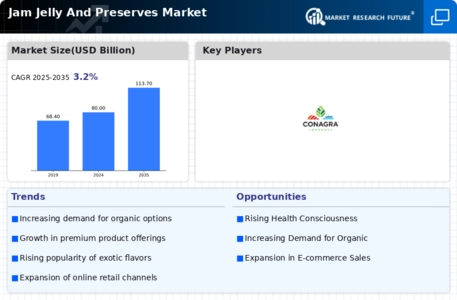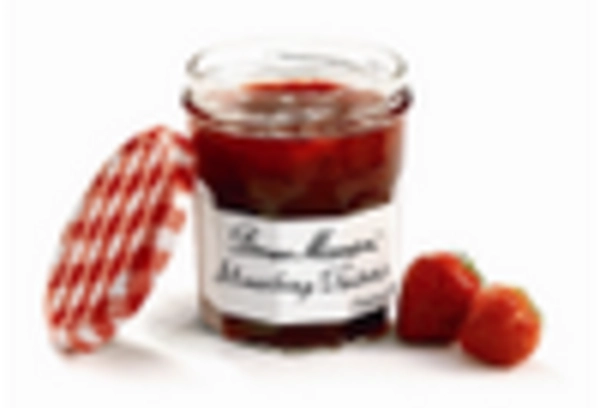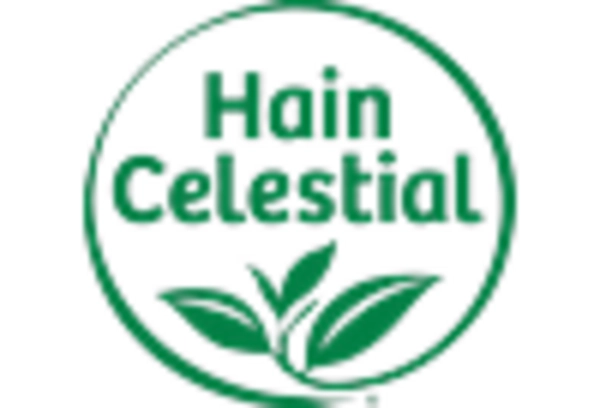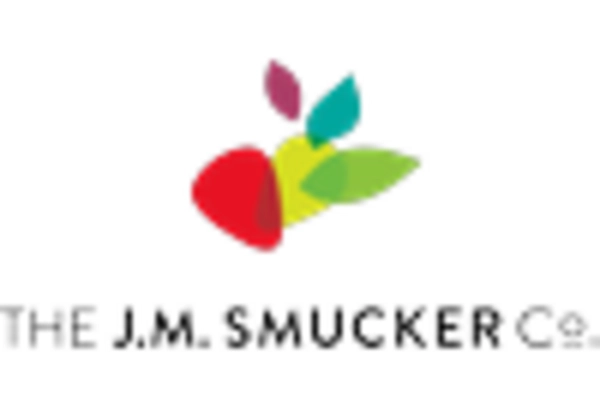Health-Conscious Choices
The increasing consumer inclination towards health-conscious choices appears to be a pivotal driver in the Jam Jelly And Preserves Market. As individuals become more aware of the nutritional content of their food, there is a growing demand for products that are low in sugar and free from artificial additives. This trend is reflected in the market, where sales of organic and natural jams have surged, indicating a shift towards healthier alternatives. In 2025, it is estimated that the health-focused segment of the market could account for a substantial portion of overall sales, suggesting that manufacturers may need to adapt their offerings to meet these evolving consumer preferences. The Jam Jelly And Preserves Market is thus likely to see an increase in product innovation aimed at health-conscious consumers.
Artisanal and Craft Products
The rising popularity of artisanal and craft products is significantly influencing the Jam Jelly And Preserves Market. Consumers are increasingly seeking unique flavors and high-quality ingredients, which has led to a surge in demand for small-batch, handcrafted jams and jellies. This trend is not merely a passing fad; it reflects a broader movement towards supporting local producers and valuing authenticity in food products. In 2025, the market for artisanal jams is projected to grow, potentially capturing a larger share of the overall market. This shift suggests that traditional mass-produced products may face challenges in maintaining their market position unless they adapt to the changing preferences of discerning consumers who prioritize quality over quantity.
Flavor Innovation and Variety
Flavor innovation and variety are critical drivers in the Jam Jelly And Preserves Market. Consumers are increasingly adventurous in their taste preferences, seeking out unique and exotic flavors that go beyond traditional offerings. This trend has prompted manufacturers to experiment with new combinations and ingredients, resulting in a diverse array of products available on the market. In 2025, it is expected that the demand for innovative flavors will continue to rise, potentially leading to the introduction of limited-edition and seasonal products. This dynamic could create opportunities for brands to differentiate themselves and capture the attention of consumers looking for novel experiences. The Jam Jelly And Preserves Market is thus likely to benefit from ongoing flavor exploration and creativity.
Convenience and On-the-Go Consumption
The trend towards convenience and on-the-go consumption is reshaping the Jam Jelly And Preserves Market. As lifestyles become increasingly fast-paced, consumers are seeking products that offer ease of use and portability. This has led to a rise in single-serve packaging and ready-to-eat options, which cater to busy individuals and families. In 2025, it is likely that the demand for convenient jam and jelly products will continue to grow, potentially driving innovation in packaging and product formats. Manufacturers may need to explore new ways to deliver their products in a manner that aligns with the needs of modern consumers. This trend suggests that the Jam Jelly And Preserves Market must adapt to the evolving landscape of consumer behavior.
Sustainability and Eco-Friendly Practices
Sustainability and eco-friendly practices are becoming increasingly important in the Jam Jelly And Preserves Market. As consumers grow more environmentally conscious, they are favoring brands that demonstrate a commitment to sustainable sourcing and packaging. This trend is evident in the rising demand for products that utilize organic ingredients and environmentally friendly packaging solutions. In 2025, it is anticipated that a significant portion of consumers will actively seek out brands that align with their values regarding sustainability. This shift could compel manufacturers to adopt greener practices, thereby enhancing their appeal in a competitive market. The Jam Jelly And Preserves Market may thus witness a transformation as companies strive to meet the expectations of eco-conscious consumers.



















Leave a Comment